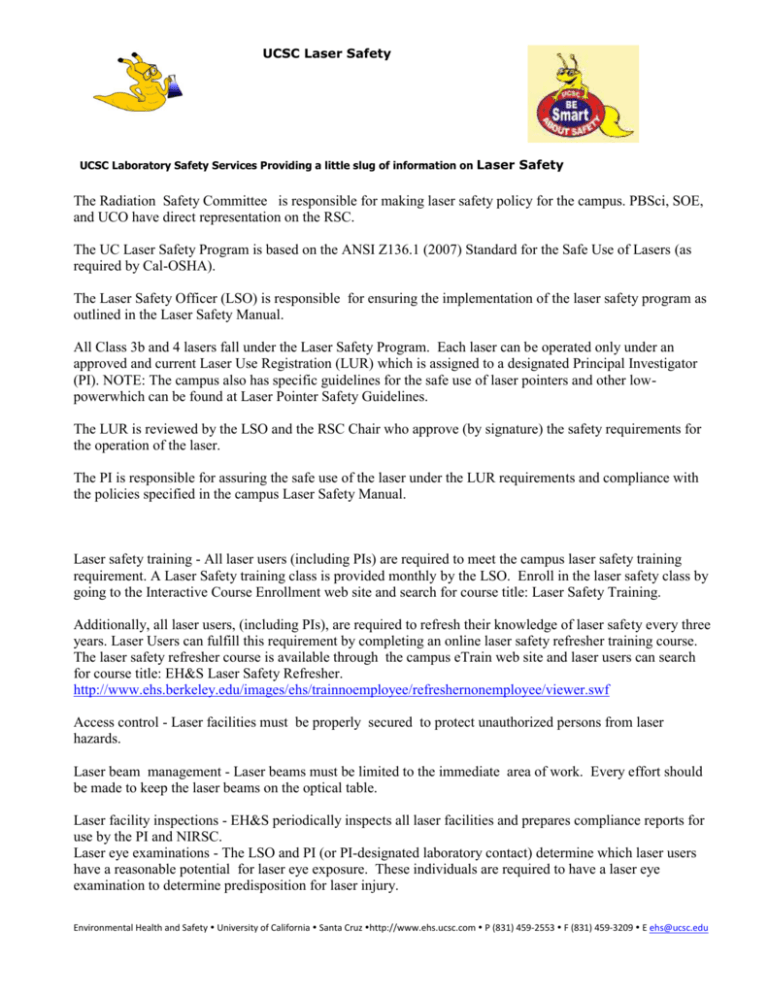Select Carcinogens and Particularly Hazardous Materials are
advertisement

UCSC Laser Safety UCSC Laboratory Safety Services Providing a little slug of information on Laser Safety The Radiation Safety Committee is responsible for making laser safety policy for the campus. PBSci, SOE, and UCO have direct representation on the RSC. The UC Laser Safety Program is based on the ANSI Z136.1 (2007) Standard for the Safe Use of Lasers (as required by Cal-OSHA). The Laser Safety Officer (LSO) is responsible for ensuring the implementation of the laser safety program as outlined in the Laser Safety Manual. All Class 3b and 4 lasers fall under the Laser Safety Program. Each laser can be operated only under an approved and current Laser Use Registration (LUR) which is assigned to a designated Principal Investigator (PI). NOTE: The campus also has specific guidelines for the safe use of laser pointers and other lowpowerwhich can be found at Laser Pointer Safety Guidelines. The LUR is reviewed by the LSO and the RSC Chair who approve (by signature) the safety requirements for the operation of the laser. The PI is responsible for assuring the safe use of the laser under the LUR requirements and compliance with the policies specified in the campus Laser Safety Manual. Laser safety training - All laser users (including PIs) are required to meet the campus laser safety training requirement. A Laser Safety training class is provided monthly by the LSO. Enroll in the laser safety class by going to the Interactive Course Enrollment web site and search for course title: Laser Safety Training. Additionally, all laser users, (including PIs), are required to refresh their knowledge of laser safety every three years. Laser Users can fulfill this requirement by completing an online laser safety refresher training course. The laser safety refresher course is available through the campus eTrain web site and laser users can search for course title: EH&S Laser Safety Refresher. http://www.ehs.berkeley.edu/images/ehs/trainnoemployee/refreshernonemployee/viewer.swf Access control - Laser facilities must be properly secured to protect unauthorized persons from laser hazards. Laser beam management - Laser beams must be limited to the immediate area of work. Every effort should be made to keep the laser beams on the optical table. Laser facility inspections - EH&S periodically inspects all laser facilities and prepares compliance reports for use by the PI and NIRSC. Laser eye examinations - The LSO and PI (or PI-designated laboratory contact) determine which laser users have a reasonable potential for laser eye exposure. These individuals are required to have a laser eye examination to determine predisposition for laser injury. Environmental Health and Safety University of California Santa Cruz http://www.ehs.ucsc.com P (831) 459-2553 F (831) 459-3209 E ehs@ucsc.edu UCSC Laboratory Safety Services Providing a little slug of information on Laser Safety Personal Protective Equipment (PPE) - Laser protective eye wear is required for laser alignments or whenever there is an open laser beam present (above safety levels). Standard Operating Procedure (SOP) - SOPs are required to document laser alignment and operations for all Class 3b and 4 laser use. These procedures must include all safety precautions (beam blocks, eye wear, hands- on training, etc.) to be followed. Posting of laser hazards – Entrances must be marked as per the ANSI standard. Laser hazard warning signs are available from EH&S. Management of non-beam hazards in laser laboratories - Many other types of hazards may exist in the laser laboratory. These hazards must be properly identified and controlled under laboratory’s Chemical Hygiene Plan and Illness and the department’s Injury Prevention Program (IIPP). Laser incidents - All laser-related incidents (eye exposures/injuries, dye spills, etc.) must be reported immediately to EH&S. Organs of concern - The human eye and to a lesser degree, the skin of the face, arms, and hands are the primary organs of concern in the laser lab. Factors to consider - Laser wavelength, beam power, continuous wave (CW) versus pulsed lasers (and pulse duration), pupil size, beam diameter, and other factors determine the risk of bioeffects. Wavelength and injury potential 200 to 400 nm - Various components of the eye (excluding the retina) and the skin may be exposed under certain conditions. Photochemical and thermal effects are both possible at these wavelengths. 400 to 1400 nm - Called the “retinal hazard region,” these wavelengths can focus on the retina, causing severe retinal burns and trauma. The eye has an optical gain of about 100,000 (1 mW/cm2 entering the eye effectively becomes 100 W/cm2 at the retina). 1400 nm to 1 mm - Surface (cornea) of the eye and skin may be burned if the beam power is sufficient ANSI hazard class and laser beam power Class 3a - From 1 milliWatt to 5 mW - Unlikely to cause eye injury unless viewed with collecting optics or for prolonged periods (greater than the 0.25 sec. aversion response time). Class 3b - From 5 mW to 500 mW - Can easily cause eye injury from intrabeam or specular reflection viewing. Class 4 - Above 500 mW - Depending on beam power, can cause eye injury from viewing diffuse reflections. Can also cause skin injuries and ignite combustible materials in the beam path. Pulsed versus continuous wave lasers - Although the CW laser will generally have greater average power, the Environmental Health and Safety University of California Santa Cruz http://www.ehs.ucsc.com P (831) 459-2553 F (831) 459-3209 E ehs@ucsc.edu UCSC Laboratory Safety Services Providing a little slug of information on Laser Safety peak power of a pulsed laser is also substantial. Average power of pulsed lasers is increasing with the high repetition rates found in newer designs. Short pulses (< 1usec.) can cause retinal damage (more than can be accounted for by thermal injury) through the formation of acoustical transients in the eye. Laser viewing conditions Intrabeam Exposure - Directly on-axis viewing of the beam. Worst case hazard, forbidden at UC Berkeley under any conditions. Specular Reflections - Mirror-like reflection from a smooth surface. Potentially as dangerous to view as intrabeam. Non-beam hazards associated with laser facilities Electrical hazards - Capacitor banks and high voltage power supplies can present severe electrical shock, burn, arc, and blast hazards. All known deaths associated with lasers have been from electrical sources. Toxic lasing media hazards –Some powered laser dyes are considered mutagenic and carcinogenic. Halogen gases used in excimer lasers are powerful oxidizers and are toxic if inhaled. Compressed gas and cryogen hazards – Properly secure all compressed gas cylinders. Cryogens can cause burns and eye injuries from contact. Leaking cylinders may present an asphyxiation hazard if ventilation is insufficient. Collateral radiation hazards - Excitation sources can produce UV and bright light hazards, as well as cause thermal burns from contact. Fire and explosion hazards - Class 4 laser beams can start fires. Solvents used in laser dyes can be extremely flammable (dye pump fires). Flashlamps can implode. EH&S web site – http://ehs.berkeley.edu EH&S phone number - 642-3073 (8-5/M-F) - 9-911 (24 hours) Contact Conrad Sherman x9-3911 RSO/LSO/Health Physicist Marcus Balanky x9-5167 ARSO/ALSO Health Physicist LSO email address csherma1@ucsc.edu In-house laser safety training sessions - Provided on request to PIs, departments, and other groups. Environmental Health and Safety University of California Santa Cruz http://www.ehs.ucsc.com P (831) 459-2553 F (831) 459-3209 E ehs@ucsc.edu UCSC Laboratory Safety Services Providing a little slug of information on Laser Safety Online laser safety refresher course – Available through the UC Berkeley campus eTrain web site.. Laser protective eyewear information and samples – Assist users on laser protective eyewear recommendations. Eyewear samples from various vendors also available. Laser safety inspections and consulting - Inspections are periodic; however special inspections are available on request. Call any time for consulting services. Laser safety equipment reference file – EH&S maintains a file of various laser and laser equipment vendors. Please call if you need information. Environmental Health and Safety University of California Santa Cruz http://www.ehs.ucsc.com P (831) 459-2553 F (831) 459-3209 E ehs@ucsc.edu UCSC Laboratory Safety Services Providing a little slug of information on Laser Safety Environmental Health and Safety University of California Santa Cruz http://www.ehs.ucsc.com P (831) 459-2553 F (831) 459-3209 E ehs@ucsc.edu UCSC Laser Safety Frequently Asked Questions and Answer UCSC Laboratory Safety Services Providing a little slug of information on . . . Contact Conrad Sherman x9-3911 RSO/LSO/Health Physicist Marcus Balanky x9-5167 ARSO/ALSO Health Physicist Revised 7/25/2011 ehs.ucsc.edu Tritium Exit signs Revised 7/25/2011 ehs.ucsc.edu






